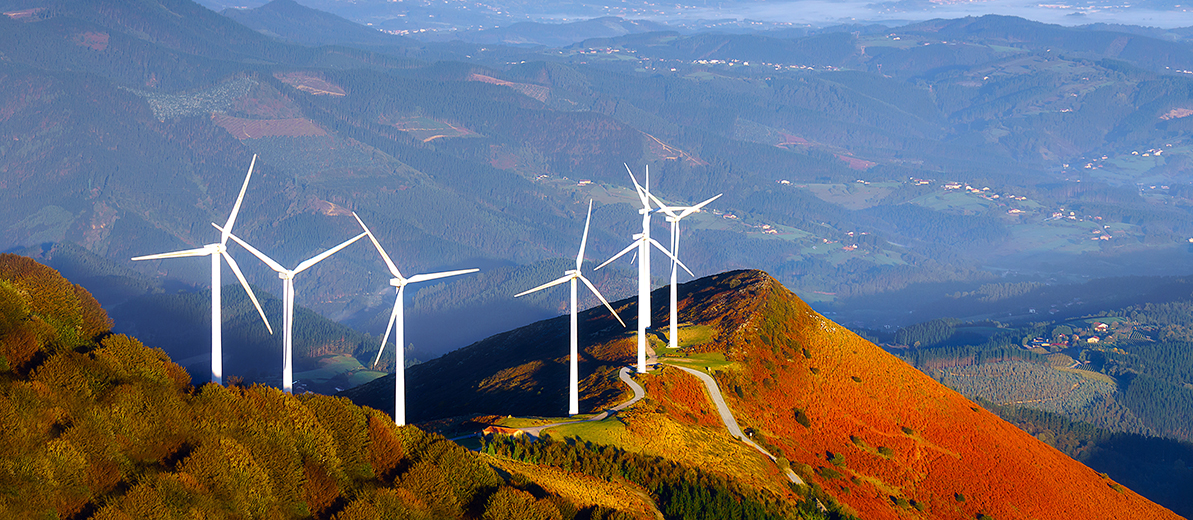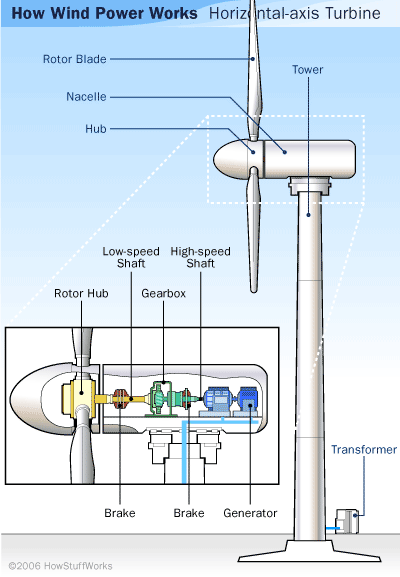
June 27, 2023
Onshore Wind Turbine Basics: Parts, Power Generation, and More
This blog post is the first in a five-part series related to onshore wind energy. The series covers topics including onshore wind turbine and wind farm basics, planning and scheduling considerations for onshore wind farms, the permitting and approval process, and construction considerations for onshore wind farms.
This first post relates to onshore wind power basics and the components of wind turbines and wind farms. Offshore wind facilities will be discussed in a separate blog post series.
Currently, there are approximately 70,000 onshore wind turbines across the United States producing nearly 140 gigawatts of clean and reliable power. This amount of power provides enough to serve 43 million homes.1 In 2022, wind power provided more than 10% of all electricity generated in the United States, making it the fourth largest source of electricity generation in the country (behind natural gas, coal, and nuclear power).2
A wind power plant, also referred to as a wind farm, includes multiple wind turbines in the same general area. As the wind turns the turbine blades on each turbine, the blades turn a rotor, which is connected via shafts and a gearbox to a generator, which produces electricity.
Each wind turbine within a wind farm includes its own transformer that converts the low voltage electricity from the turbine generator into higher voltage electricity for transmission. Each wind turbine/transformer is connected to the electrical transmission system within the wind farm, which then connects to a substation that links the wind farm to the electrical distribution system/grid.
An individual wind turbine and its components are shown in the figure below:
Figure 1: Parts of a Wind Turbine3

Note that the figure above displays a horizontal axis wind turbine. A variation of this turbine is the vertical axis turbine, which is not commonly used. Each of the main components of a horizontal axis wind turbine is described briefly below.
Rotor Blade: The rotor blades are made of fiberglass, and a typical wind turbine has three blades. The blades vary in size, but a typical land-based wind turbine blade is typically over 170 feet in length. The blades function similar to an airfoil—as the wind flows across the rotor blades, the air pressure on one side of the blade decreases, and the difference in air pressure across the blade creates lift and drag. The lift force is greater than the drag force, which causes the blade to spin.
Nacelle: The nacelle is the part of the wind turbine that sits on the tower and houses the electrical and mechanical components of the turbine. For a large wind turbine, the nacelle may be larger than a house. As shown in the figure above, within the nacelle are the brakes, low and high-speed shafts, gearbox, and generator. Not shown is the electrical distribution equipment, yaw system (not in all turbines), and the controller.
Attached to the nacelle are the wind vane and anemometer. The wind vane measures wind direction and communicates with other parts of the turbine to position the turbine based on the wind direction. The anemometer measures wind speed and transmits data to the controller.
Rotor Hub: The rotor hub is the mechanical link between the rotor blades and the main shaft bearing.
Tower: The tower provides the support for the nacelle and anchors the structure to the earth through the foundation. The tower is typically made of tubular steel and provides access to the nacelle, as well as containing the electrical cables between the nacelle and the transformer.
Transformer: Located at the base of the tower (or within the tower), the transformer converts the low voltage electricity from the turbine generator into higher voltage electricity for transmission.
Foundation: This is shown but not labeled in the figure above. The foundation is a key structural component of the wind turbine and is the concrete structure that anchors the tower to the earth. The size of the foundation is based on the size and weight of all the components of the wind turbine as well as the compressive and uplift forces from the wind and rotation of the rotor blades. Depending on the size of the turbine and/or the geotechnical conditions, the foundation may include piles or drilled piers.
Other facilities within the wind farm include access roads, electrical distribution systems, crane pads, an operation/maintenance facility, and potentially an electrical substation. The locations for wind farms are carefully considered, and factors include terrain and geological factors, wind conditions, and access to electrical transmission mains. Construction of these facilities will be addressed in the fifth blog post of this series.
Because wind speeds are typically greater at higher elevations, wind turbines are tall structures. Generally, every approximately 33-foot increase in tower height results in wind speeds that are 2% to 3% stronger, yielding 3% to 5% more energy.4 Taller towers can also accommodate longer rotor blades. The turbines can be measured by their hub height, which is the distance from the ground to the middle of the turbine’s rotor. Another term used to measure the physical size of a wind turbine is the rotor diameter, which is the diameter of the circle made by the rotating blades.
As of 2021, the average hub height for a utility-scale, land-based wind turbine was approximately 308 feet.5 The average rotor diameter was 418 feet. Longer turbine blades and associated larger rotor diameters capture more wind than shorter turbine blades. This proves advantageous for areas that are less windy but can still benefit from wind power by use of large turbines.
Wind turbine energy output is referred to as nameplate capacity (or rated capacity). This refers to the amount of energy produced if the turbine ran at optimal wind speeds on a consistent basis. In 2021, the average nameplate capacity of a single new wind turbine was 3.0 megawatts. This power output per turbine represents a 319% increase above those turbines installed in the late 1990s.6
Two important items related to the power generation of the wind turbine are the cut-in speed and the cut-out speed. The cut-in speed refers to the wind speed required to begin generating electricity. Generally, wind turbines begin generating electricity at wind speeds around 6.7 mph.7 Too much wind can be harmful to the mechanical components of the wind turbine, which necessitates the cut-out speed. Turbine cut-out speeds are approximately 55 mph. Optimal wind speeds for power generation occur between 26 and 30 mph.8
Now that we’ve covered how a wind turbine works and wind power basics, we can discuss wind farm planning.
1 “Wind Power Facts,” American Clean Power, accessed April 3, 2023. https://cleanpower.org/facts/wind-power/.
2 “Frequently Asked Questions (FAQS),” U.S. Energy Information Administration, accessed April 3, 2023. https://www.eia.gov/tools/faqs/faq.php?id=427&t=3.
3 “howstuffworks,” How Wind Power Works, accessed April 3, 2023. https://science.howstuffworks.com/environmental/green-science/wind-power.html.
4 “Wind Energy Basics,” New York Wind Energy Guide for Local Decision Makers, accessed April 16, 2023. https://www.nyserda.ny.gov/-/media/Project/Nyserda/Files/Publications/Research/Biomass-Solar-Wind/NY-Wind-Energy-Guide-1.pdf.
5 “Wind Turbines: the Bigger, the Better,” Office of Energy Efficiency & Renewable Energy, accessed April 6, 2023. https://www.energy.gov/eere/articles/wind-turbines-bigger-better#:~:text=Report%3A%202022%20Edition.-,Hub%20Height,as%20the%20Statue%20of%20Liberty!
6 “Wind Turbines: the Bigger, the Better.”
7 “Wind Energy Basics.”
8 “Wind Energy Basics.”
ADDITIONAL RESOURCES

Blog
Discover industry insights on construction disputes and claims, project management, risk analysis, and more.
MORE

Articles
Articles by our engineering and construction claims experts cover topics ranging from acceleration to why claims occur.
MORE

Publications
We are committed to sharing industry knowledge through publication of our books and presentations.
MORE
RECOMMENDED READS
Carbon Capture – A Capital-Intensive Technology with Large Growth Potential
This is the first post in a six-part series that discusses carbon capture, utilization, and sequestration (CCUS).
READ
Construction Claim Types for Contractors
U.S. federal and state courts recognize 19 basic construction claim entitlements for a contractor’s recovery of damages. This post is the first of a series discussing each of these 19 types.
READ
Definitions of Construction Claim Types for Contractors
The author summarizes the definitions of the 19 construction claim types that may apply to a contractor's and subcontractor's recovery of time and costs.
READ

